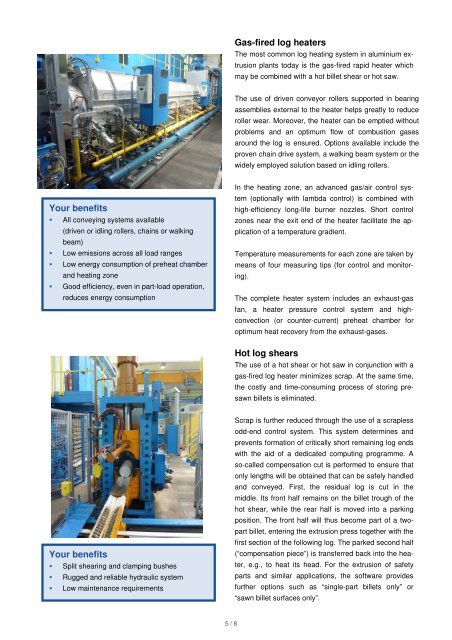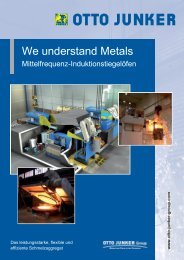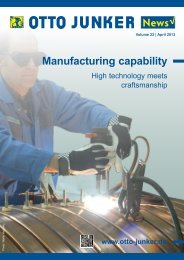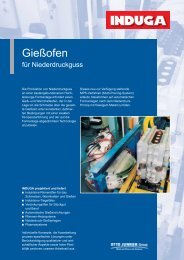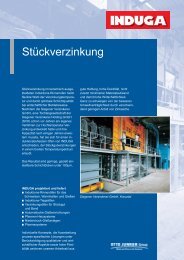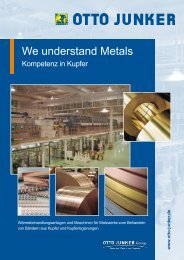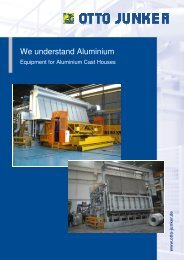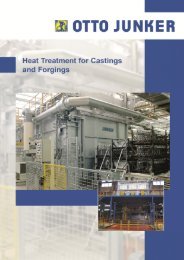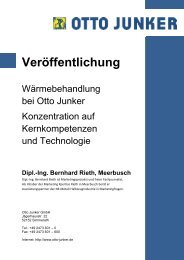Aluminium Extrusion Plants - Otto Junker GmbH
Aluminium Extrusion Plants - Otto Junker GmbH
Aluminium Extrusion Plants - Otto Junker GmbH
Create successful ePaper yourself
Turn your PDF publications into a flip-book with our unique Google optimized e-Paper software.
Gas-fired log heaters<br />
The most common log heating system in aluminium extrusion<br />
plants today is the gas-fired rapid heater which<br />
may be combined with a hot billet shear or hot saw.<br />
The use of driven conveyor rollers supported in bearing<br />
assemblies external to the heater helps greatly to reduce<br />
roller wear. Moreover, the heater can be emptied without<br />
problems and an optimum flow of combustion gases<br />
around the log is ensured. Options available include the<br />
proven chain drive system, a walking beam system or the<br />
widely employed solution based on idling rollers.<br />
Your benefits<br />
All conveying systems available<br />
(driven or idling rollers, chains or walking<br />
beam)<br />
Low emissions across all load ranges<br />
Low energy consumption of preheat chamber<br />
and heating zone<br />
Good efficiency, even in part-load operation,<br />
reduces energy consumption<br />
In the heating zone, an advanced gas/air control system<br />
(optionally with lambda control) is combined with<br />
high-efficiency long-life burner nozzles. Short control<br />
zones near the exit end of the heater facilitate the application<br />
of a temperature gradient.<br />
Temperature measurements for each zone are taken by<br />
means of four measuring tips (for control and monitoring).<br />
The complete heater system includes an exhaust-gas<br />
fan, a heater pressure control system and highconvection<br />
(or counter-current) preheat chamber for<br />
optimum heat recovery from the exhaust-gases.<br />
Hot log shears<br />
The use of a hot shear or hot saw in conjunction with a<br />
gas-fired log heater minimizes scrap. At the same time,<br />
the costly and time-consuming process of storing presawn<br />
billets is eliminated.<br />
Your benefits<br />
Split shearing and clamping bushes<br />
Rugged and reliable hydraulic system<br />
Low maintenance requirements<br />
Scrap is further reduced through the use of a scrapless<br />
odd-end control system. This system determines and<br />
prevents formation of critically short remaining log ends<br />
with the aid of a dedicated computing programme. A<br />
so-called compensation cut is performed to ensure that<br />
only lengths will be obtained that can be safely handled<br />
and conveyed. First, the residual log is cut in the<br />
middle. Its front half remains on the billet trough of the<br />
hot shear, while the rear half is moved into a parking<br />
position. The front half will thus become part of a twopart<br />
billet, entering the extrusion press together with the<br />
first section of the following log. The parked second half<br />
(“compensation piece”) is transferred back into the heater,<br />
e.g., to heat its head. For the extrusion of safety<br />
parts and similar applications, the software provides<br />
further options such as “single-part billets only” or<br />
“sawn billet surfaces only”.<br />
5 / 8


